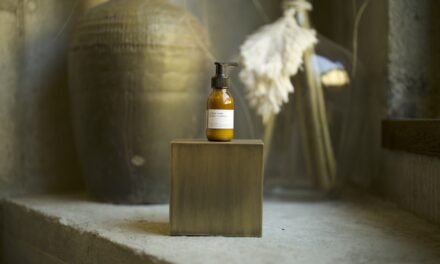
MAD About Everything–In All the Best Ways

Unlike many designers and architects, Timothy Jung, the creator of MAD Designer Stage, does not have a fixed style and direction in design. As Jung says, “There’s nothing new in this world. To me, the most important thing, is how to use different inspirations, styles, collective unconsciousness, emotions, materials and knowledge from others to weave an unprecedented new tapestry. It is about making irrelevant objects, artifacts, decors coexist in a spatial space in harmony, transcending norms, trend and fashion. We don’t like expected answers! We learn through observations and first-hand experiences with no hypothesis to start with, because they limit your imagination as well as the aesthetics!”
Two Degrees of Separation
Common wisdom says that there are six degrees of separation between most people. I believe there are only two. Whatever algorithm LinkedIn uses to make suggestions based on similar interests, passions, possible business connections and groups, I will always be grateful they connected me with Timothy Jung in my online realm. Our online connection morphed from virtual to reality last summer when I was in the UK working to create experiences for my travel clients. We met in London while Jung was attending a photography course, one of many he takes each year to challenge himself and his perspectives. Our meetings covered a diverse range of topics: hotels, music, food, art, design (from furniture, to interior to total building design or re-imagination), travel, fashion, photography, film and even psychology. We covered everything from the sublime to the ridiculous–ridiculously amazing, that is. Timothy Jun epitomizes the Renaissance Man, finding his inspiration anywhere and everywhere.
A Unique Journey To Design
Timothy was brought up by his grandfather. Together, they traveled extensively, sparking his youthful mind and nourishing his soul by seeing how it was possible to create something amazing from nothing. He was imbued with the value of listening to people and observing them in a non-judgmental manner. Thus began his passion for the arts.
When Jung was a young boy, Canada turned down his application to come to Vancouver, Canada to live with his family and study. We might have been neighbors! Instead, he ended up at an old traditional Harry Potter-style British boarding school, and later went on to marry a concert pianist (who also was the Choir Mistress of the Royal Parish Church, St. Martin-in-the-Field). He studied Art Psychotherapy at London’s Goldsmiths College, the training ground for Mary Quant and Damien Hurst. When he decided he “knew too little,” he spent the next eight years training in psychotherapy and philosophy at the University of London.
Jung’s quest for knowledge continued by studying Hotel Interior Architecture & Furniture Design at the Central St Martins & Chelsea College of Art. So began the evolution that led Timothy to choose Jung as his surname, in a continuing homage to Carl Jung and analytical psychology. Why? “Morris Nitsun (A leading figure of British Group Analysis) often referred to me as ‘Jung,’ and I liked the new identity he gave me. To me, the name means discernment, deep understanding of the nature of a matter and a humble attitude toward something new. It was a new individual identity apart from the highly successful ‘YUNG’s’ and allowed me to become the ‘little me’!”
The Beginnings Of A MAD Career
Jung spent his early career in various hotels in different cities and managed some of the grandest, palatial hotels in London, including the Mandarin Oriental and The Ritz, over two decades ago. “You will be greeted in the manner that a butler at a top London hotel receives royalty,” he says. “You will be made to feel part of the family and have the chance to socialize with fellow guests, should you so wish.” This mantra was developed early in his life.
He served as a member of an advisory panel in community development for the British Government, and possesses an extensive global network. His passion and experience ranges from great support to classical musicians to partnering with the former lead architect of the Prince of Wales’s Prince’s Foundation and the forefather of East London regeneration, Noel Isherwood. The two men share a vision of regeneration as a means of improving people’s daily lives in the short and long term.
Isherwood and Jung co-designed a few hotels together, one in London and a few in Swansea. Their dream? Creating thirty unique luxury-themed boutique hotels in the next decade, allowing them to nurture and cultivate the next generation of British craftsmen, designers and engineers, as well as creating permanent jobs and contributing to local economies. Think ‘Haute Couture’ for living beyond fashion.
“It was me down to a tee!” says Jung. “I had a near-fatal car accident and found myself in the wrong chair in the therapy room, unable to practice as a therapist, so I decided to pursue something about which I had great passion, realizing the fragility of life.”
After the accident, he founded the MAD Designer Stage at The Newton Institute, opened his Interior & Haute Fidelity Couture Studio at Whitehall, and became a neighbor of the British Prime Minister and the horses of Her Majesty.
The MAD Conductor At The Music Fable Hotel
Jung’s current project is the private member club-style themed boutique hotels called The Fables, envisioned with Noel Isherwood. “We aim to promote networking with like minded people to shape a new future, initially in British cities and extending to other cities in the world. It is not just another ‘Boutique Hotel,’ which itself is a new concept. It uses the Boutique Hotel as a catalyst to bring together a hub of cultural regeneration and innovation by expanding the concept to embrace economic recovery including the circular economy.” Through collaborating with local communities, talented young artists, designers and crafts people will bring interest and diversity to the region–and assist with the overall cultural experience of the city. The self supporting and funded project will hopefully encourage people to dream dreams in an inspiring fantasy environment. “I am a sculptor of space, and love filling it with sound, colour, atmosphere, scents and dreams.”
This latest project came about via a rather circuitous path. He acquired a row of beautiful properties overlooking the seven-mile-long, sandy beaches along Swansea Bay, which included one of the few surviving Victorian buildings in the area, dating from 1875. The carefully designed interiors complement the beauty of the original features of the Victorian building (a former family home for the Duke of Beaufort in the 1900s), giving the hotel an eccentric touch with a Victorian style. All rooms and suites are named after musicians, except the Jung & Freud Suites, which take their name from the modern Jung-Freud dialogue between Timothy and Jane McAdam Freud (daughter of Lucian Freud) and the grandchildren of Sigmund Freud.
From this, emerged The Music Fable Hotel, re-imagined into an eclectic, nuanced and layered quirky hotel experience combined with the feel of a private club.
The Music Fable currently has twelve bedrooms, and given the constrictions of the footprint, the hotel has been optimally laid out to feel as spacious as possible, with guests entering through the music house. The exterior’s black painted brickwork and gold exterior trim are reflected in the quirky, cozy and comfy living and sleeping spaces. The bathrooms are Art Deco–inspired, and the highest quality bed linens ensure a luxurious sleep once you finish exploring the rooms.
The Bach Suite is designed to give a unique dream-like experience. Containing a Victorian bath overlooking a panoramic sea view, the carefully designed interior of the suite complements the beauty of the original cornice, and the Victorian marble fireplace is sourced from a nearby castle. A contemporary Italian high gloss floor is equipped with underfloor heating to warm your feet, and there’s a bespoke designed sound system like the ones used in concert halls.
A suite that you really must experience is a uniquely sensual, romantic haven. The Elgar Suite is one of Jung’s most sophisticated designs. It was inspired by Lady Weinberg (Interior Designer for Louis Vuitton) and pays homage to the great British composer and conductor, Edward Elgar. An exotic, romantic space, the suite offers a classic and contemporary fusion in a sophisticated setting with Françoise, Anglo and Chinoiseries elements. There is a French parquet floor, a Louis-style fireplace and golden, heavyweight fabrics with detailed embroidery and tassel trims in a Victorian style. The Middle Kingdom-style cabinet and leather traveler’s trunk add even more Victorian design elements to the room. You can even experience Elgar’s musical prowess yourself, as heard through the bespoke My Audio Design sound system. The room’s elegance and romanticism is unique, combining history, legend, luxury and theatre.
Nothing was left to chance in this three-year massive renovation, from the lighting to the art, fabrics, sound systems and colour schemes to the curated collections of books and music as an homage to each musician and of course, Carl Jung. It is precisely that quirkiness that has attracted a long list of Who’s Who guests, from British automotive designers, television producers, models, footballers, musicians and music producers to world leaders, fashion shoots, festival-goers and a few unsuspecting guests looking for an extraordinary experience at the seaside. The current twelve rooms are charming, intricately detailed suites, where personalized butler service will make you feel like royalty, or at least a celebrity!
Nothing is predictable about Jung’s work, except for the tremendous attention to the smallest detail. “My world is like a kaleidoscope; nothing is what it supposed to be.” Jung added, “I want to make the spaces I design a sensory treat, with visual, auditory, olfactory and somatic stimulation. I love infusing old and new world themes, to give a state of great, lasting pleasure.”
Creating A Luxury Loudspeaker
Jung is always finding inspiration everywhere–and anywhere. This led his work to take on a multi-disciplinary approach. Timothy’s first interior commission was to design a Music Heaven for a prominent world figure. The client’s brief was: “I don’t know what I want, I want the best things in the world, nothing really satisfies me.”
“At the time I was working on the commissioning of the Royal Salute Loudspeaker with Simon Benney (The Queen’s Goldsmith) and a bunch of quirky designers, said Jung. “The client asked whether I can create an even better one for him, with better sound and a better look. I suggested a home visit to learn more about him. Eventually we spent months together in different activities, in order to understand his deepest longings.
“Instead of just a pair of bespoke loudspeakers, I designed and developed a unique soulful Music Heaven (Room), loudspeakers and the entire sound system for his mansion. With some of the MADdest concepts in the world, we employed automotive pneumatic suspension technology in super cars like the ‘Range Rover’ under the floor, alongside with a lot of marble slabs and cornice for this music room and library. This bespoke sound system was custom designed to suit the spatial requirements of the client. I listened and observed their unconscious needs and desires and created something that exceeded their expectations.
“It was a unique place, not just another trendy, all the same kind of so -called fashionable design. The loudspeakers were developed in collaboration with a close group of Musicians! We let them listen to a new prototype every week for six months and observed their unconscious communications. To put it in simple terms, it is: How does their heart orchestrate within the SOUND? We didn’t ask for their comments, but we could see the changes in their reactions and communication. After the design changes, the information I gathered from these group observations enabled me to work with different professionals, such as material scientists, acoustic specialists, mechanical engineers, electronics engineers, product designers and master craftsman to co-create perfect pieces. The musician’s unconscious link to the tonal balance allowed me to find out what was the intrinsic beauty of sound to their ears that penetrated their soul, rather than a just a subjective opinion! This is revolutionary.
“Given my psychoanalytic training and mindset, it was very natural to perceive the unconscious minds of these musical maestros. That allowed me to test how the voicing of my speakers affects their perception of the music and the emotion that follow. Music is all about the unconscious communication in feeling between artists and audience, and I need to fine- tune my speakers, so they best enable this.”
All this feedback gets digested and then gets passed on to his speaker design engineers of his MAD Designer Stage. They hone every aspect from the cabinets to the drive units and crossovers. He has an eclectic group of artisans and technicians, including a former Soviet missile engineer all the way to a Royal Warrant holding artisan. “Obviously it takes many sessions to touch everyone’s inner soul”, he says. “Cost puts a full stop to it for other companies, because it isn’t really commercially viable, and they don’t have the expertise to do such kind of pseudo science research.”
MAD Loudspeakers are distinctive. They don’t follow trends in sound or style. Instead, they possess an authentic route to reach deeply into the emotion in the music, and let it touch you as lightly as a feather to enchant you in their own way. Virtuoso cellist Julian Lloyd Weber is one notable fan, saying that, “It is every musician’s dream to hear the sound they heard when they were recording, truly reproduced… through these speakers. My dream has finally come true.” If you are a fan of his quirky imagination, and money is not an object, then bespoke, limited- edition speakers are MAD to order. The World is a MAD Designer Stage: and he is a sculptor of space, sound & love!
Images courtesy of Timothy Jung. Feature image: Jung & Hi End Audio Doyen Jonathan Midgley






















